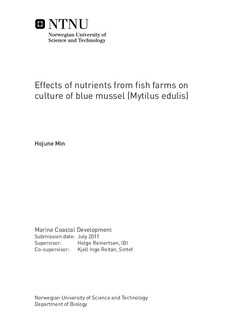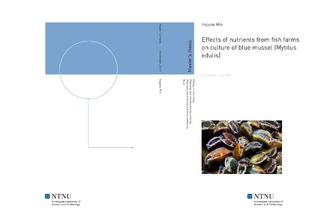| dc.contributor.advisor | Reinertsen, Helge | nb_NO |
| dc.contributor.advisor | Reitan, Kjell Inge | nb_NO |
| dc.contributor.author | Min, Hojune | nb_NO |
| dc.date.accessioned | 2014-12-19T13:12:11Z | |
| dc.date.available | 2014-12-19T13:12:11Z | |
| dc.date.created | 2011-11-14 | nb_NO |
| dc.date.issued | 2011 | nb_NO |
| dc.identifier | 456226 | nb_NO |
| dc.identifier | ntnudaim:6569 | nb_NO |
| dc.identifier.uri | http://hdl.handle.net/11250/244905 | |
| dc.description.abstract | Intensive salmonid cage culture releases nutrients and organic matter that lead eutrophication of coastal waters. Integrated multi-trophic aquaculture (IMTA) is receiving great attention as a means of reducing organic/inorganic nutrient loads to the environment and increasing productivity by rearing viable secondary organisms. In this study blue mussels (Mytilus edulis) were cultured close to a salmon (Salmo salar) cage farm at Tristen, Bjugn in Sør Trøndelag, Central Norway from June 2010 to February 2011. 3 experimental stations at the fish farming area and 2 reference stations (1.8 and 3.6 km away from the fish farm, respectively) were positioned to test if the integrated mussel culture reduces the environmental impact from salmon cage culture.Highest water temperature recorded was 14.3 °C in July. Water temperature was above 10 °C until middle of October and the lowest was 3.1 °C in winter. Total particulate matter (TPM) and chlorophyll a contents varied 6.3 10.5 mg L-1 and 0.1 - 2.5 µg L-1, respectively. The mussel (n=450) length increased from 31.1±0.04 mm (standard length±SE) to 41.5±0.17 mm. The mussel growth was high in summer (June September) and was close to zero in the winter (October February). Multiple regression analysis showed that water temperature was the prime factor affecting condition index (CI) (meat dry weight/shell dry weight) and specific growth rate (SGR) of mussel. No differences were found in the environmental variables and food availabilities among the stations. Significantly higher CIs at the experimental stations (station 1, 2 and 3) than at the reference stations were caused by utilization of fish farm discharges by the mussels. Fatty acids 18:1 (n-9), 18:2 (n-6) and 20:5 (n-3) signatures and the ratio of n-3 to n-6 in the digestive gland tissue of mussels collected in February support the findings. SGR in shell length was highest at reference station 5 (0.29 % day-1 in summer and 0.02 % day-1 in winter). This result might be caused by slow current speed at the station.It is concluded that, mussels may play an important role reducing environmental impact from salmon farm and it gives a possibility to integrating mussels on the salmon cage culture. | nb_NO |
| dc.language | eng | nb_NO |
| dc.publisher | Institutt for biologi | nb_NO |
| dc.subject | ntnudaim:6569 | no_NO |
| dc.subject | MSMACODEV Marine Coastal Development | no_NO |
| dc.subject | Aquaculture | no_NO |
| dc.title | Effects of nutrients from fish farms on culture of blue mussel (Mytilus edulis) | nb_NO |
| dc.type | Master thesis | nb_NO |
| dc.source.pagenumber | 61 | nb_NO |
| dc.contributor.department | Norges teknisk-naturvitenskapelige universitet, Fakultet for naturvitenskap og teknologi, Institutt for biologi | nb_NO |

